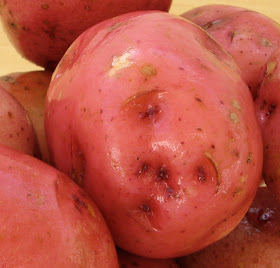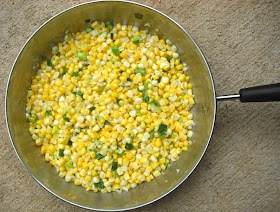This isn't your grandmother's potato salad. But next to hers, I love this one. It's simple and "clean." Whenever I make it, usually in the summer months, I always question myself, "Why don't you make this more often?"
A cold potato salad is perfect fare for the hot summer months. And it goes with just about anything from hamburgers to steaks to salmon. It's a meal in and of itself with a fresh, from-the-garden tomato dressed with olive oil and aged Balsamic vinegar and a slice or two of sweet melon for dessert. It's not necessary to use fresh dill for this, but it is imperative to use fresh basil--and don't skip the lemon.
Use small red potatoes since they are waxier than Idaho potatoes. Scrub, but don't peel. After they are cooked, the peels will begin to slip off as you cut them. I like a bit of the peel to show in the PS. This recipe is easily cut in half.

- 3 pounds red potatoes
- 3 tablespoons rice vinegar (seasoned or unseasoned)
- 3/4 cup real mayonnaise
- 1/2 cup thinly-sliced green onions, white and green parts
- 1/2 cup celery, diced (split large stalks into fourths lengthwise then dice)
- 1/4 cup finely-chopped fresh parsley
- 1/4 cup chopped fresh basil
- 2 tablespoons chopped fresh dill or 1 tablespoon dry
- 1 1/2 teaspoons finely grated lemon peel
- Salt
- Pepper
(Serves 6-8)
Lightly scrub potatoes and leave on the skin. If potatoes are large, cut in half. Place in a large pot of salted water and bring to a boil. Reduce heat to medium and boil just until tender, about 10-15 minutes or so until the tip of a sharp knife easily pierces the flesh. Drain. Rinse with cold water and drain. Allow to sit until cool enough to handle.
Cut potatoes into 3/4-inch pieces removing some of the peel as you go. Place one layer in a large bowl and sprinkle with a bit of the vinegar and salt and pepper. Repeat layers with vinegar, salt and pepper. Taste. Add more salt and pepper if necessary.
Sprinkle grated lemon peel over potatoes. Mix. Now add the rest of the ingredients. Mix thoroughly. Chill and enjoy (but I think it's wonderful still warm).
Notes: Potatoes take a lot of salt, so be sure to taste, taste, taste. When people complain that a potato salad is "bland," it's usually because it doesn't have enough salt. I've made this without the parsley and it's just fine. A garnish of radishes cut razor-thin makes a lovely presentation.




































